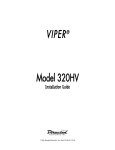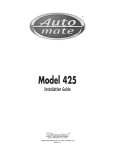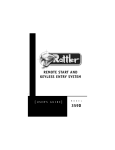Download Rattler 310D Installation guide
Transcript
310D ➤Owner’s/Installation Guide limited lifetime consumer warranty For a period of one calendar year from the date of purchase of this auto-security device, Directed Electronics, Inc. promises to the ORIGINAL PURCHASER to repair or replace (with a comparable reconditioned model), free of cost, any electronic control module which proves to be defective in workmanship or material under normal use, SO LONG AS THE SYSTEM WAS SOLD, INSTALLED, AND SERVICED BY A PROFESSIONAL AUTO INSTALLER, AND REMAINS IN THE CAR IN WHICH THE SYSTEM WAS ORIGINALLY INSTALLED. If warranty service is necessary you must have a clear copy of your sales receipt containing all of the information shown on the following page. After the first calendar year, from the date of purchase of this auto-security device, Directed Electronics, Inc., promises to the ORIGINAL PURCHASER to repair or replace (with a comparable reconditioned model) any electronic control module which proves to be defective in workmanship or material under normal use FOR A CHARGE OF $45.00, SO LONG AS THE SYSTEM WAS SOLD, INSTALLED, AND SERVICED BY A PROFESSIONAL AUTO INSTALLER, AND REMAINS IN THE CAR IN WHICH THE SYSTEM WAS ORIGINALLY INSTALLED. If warranty service is necessary you must have a clear copy of your sales receipt containing all of the information shown on the following page. This warranty contains the entire agreement relating to warranty and supersedes all previous and contemporaneous representations or understandings, whether written or oral. IN ANY EVENT, DIRECTED ELECTRONICS, INC. IS NOT LIABLE FOR THE THEFT OF THE VEHICLE AND/OR ITS CONTENTS. This warranty is void if the product has been damaged by accident, unreasonable use, neglect, improper service or other causes not arising out of defects in materials or construction. This warranty is nontransferable and does not apply to any unit that has been modified or used in a manner contrary to its intended purpose and does not cover batteries. The unit in question must be returned to the manufacturer, postage prepaid. This warranty does not cover labor costs for the removal, diagnosis, troubleshooting or reinstallation of the unit. For service on an out-of-warranty product a flat rate fee by model is charged. Contact your authorized dealer to obtain the service charge for your unit. These systems are a deterrent against possible theft. Directed Electronics, Inc. is not offering a guarantee or insuring against the theft of the automobile or its contents and disclaims any liability for the theft of the vehicle and/or its contents. Directed Electronics does not authorize any person to create for it any other obligation or liability in connection with this security system. © 2003 directed electronics, inc. i TO THE MAXIMUM EXTENT ALLOWED BY LAW, ANY AND ALL WARRANTIES ARE EXCLUDED BY THE MANUFACTURER AND EACH ENTITY PARTICIPATING IN THE STREAM OF COMMERCE THEREWITH. THIS EXCLUSION INCLUDES BUT IS NOT LIMITED TO THE EXCLUSION OF ANY AND ALL WARRANTY OF MERCHANTABILITY AND/OR ANY AND ALL WARRANTY OF FITNESS FOR A PARTICULAR PURPOSE AND/OR ANY AND ALL WARRANTY OF NON-INFRINGEMENT OF PATENTS, IN THE UNITED STATES OF AMERICA AND/OR ABROAD. NEITHER THE MANUFACTURER OR ANY ENTITIES CONNECTED THEREWITH SHALL BE RESPONSIBLE OR LIABLE FOR ANY DAMAGES WHATSOEVER, INCLUDING BUT NOT LIMITED TO ANY CONSEQUENTIAL DAMAGES, INCIDENTAL DAMAGES, TOWING, REPAIR, REPLACEMENT, DAMAGES FOR LOSS OF TIME, LOSS OF EARNINGS, COMMERCIAL LOSS, LOSS OF ECONOMIC OPPORTUNITY AND THE LIKE. NOTWITHSTANDING THE ABOVE, MANUFACTURER DOES OFFER A LIMITED WARRANTY TO REPLACE OR REPAIR THE CONTROL MODULE AS DESCRIBED ABOVE. Some states do not allow limitations on how long an implied warranty will last or the exclusion or limitation of incidental or consequential damages. This warranty gives you specific legal rights, and you may also have other rights which vary from state to state. IMPORTANT NOTE: This product warranty is automatically void if its date code or serial number is defaced, missing, or altered. This warranty will not be valid unless you have completed the warranty card and mailed it to Directed Electronics, Inc. within 10 days after purchase to the address listed on the warranty registration card. Make sure you have all of the following information from your dealer: A clear copy of the sales receipt, showing the following: ➤ ➤ ➤ ➤ ➤ ➤ ➤ ➤ ➤ ii Date of purchase Your full name and address Authorized dealer's company name and address Type of alarm installed Year, make, model and color of the automobile Automobile license number Vehicle identification number All security options installed on automobile Installation receipts © 2003 directed electronics, inc. table of contents limited lifetime consumer warranty . . . . . . . . . . . . . . . . . . . . . . . . . . . . . . . . . . . . . . . . i what is included . . . . . . . . . . . . . . . . . . . . . . . . . . . . . . . . . . . . . . . . . . . . . . . . . . . . . . 3 installation tools . . . . . . . . . . . . . . . . . . . . . . . . . . . . . . . . . . . . . . . . . . . . . . . . . . . . . . 3 important information . . . . . . . . . . . . . . . . . . . . . . . . . . . . . . . . . . . . . . . . . . . . . . . . . 4 system maintenance . . . . . . . . . . . . . . . . . . . . . . . . . . . . . . . . . . . . . . . . . . . . . . 4 your warranty . . . . . . . . . . . . . . . . . . . . . . . . . . . . . . . . . . . . . . . . . . . . . . . . . . . 5 fcc/id notice . . . . . . . . . . . . . . . . . . . . . . . . . . . . . . . . . . . . . . . . . . . . . . . . . . . . 5 primary harness (H1), 12-pin connector . . . . . . . . . . . . . . . . . . . . . . . . . . . . . . . . . . . 6 relay harness (H2), 6-pin connector . . . . . . . . . . . . . . . . . . . . . . . . . . . . . . . . . . . . . . . 7 installation . . . . . . . . . . . . . . . . . . . . . . . . . . . . . . . . . . . . . . . . . . . . . . . . . . . . . . . . . . 8 step 1 . . . . . . . . . . . . . . . . . . . . . . . . . . . . . . . . . . . . . . . . . . . . . . . . . . . . . . . . . 9 step 2 . . . . . . . . . . . . . . . . . . . . . . . . . . . . . . . . . . . . . . . . . . . . . . . . . . . . . . . . 10 step 3 . . . . . . . . . . . . . . . . . . . . . . . . . . . . . . . . . . . . . . . . . . . . . . . . . . . . . . . . 11 step 4 . . . . . . . . . . . . . . . . . . . . . . . . . . . . . . . . . . . . . . . . . . . . . . . . . . . . . . . . 13 step 5 . . . . . . . . . . . . . . . . . . . . . . . . . . . . . . . . . . . . . . . . . . . . . . . . . . . . . . . . 14 step 6 . . . . . . . . . . . . . . . . . . . . . . . . . . . . . . . . . . . . . . . . . . . . . . . . . . . . . . . . 15 step 7 . . . . . . . . . . . . . . . . . . . . . . . . . . . . . . . . . . . . . . . . . . . . . . . . . . . . . . . . 31 step 8 . . . . . . . . . . . . . . . . . . . . . . . . . . . . . . . . . . . . . . . . . . . . . . . . . . . . . . . . 32 step 9 . . . . . . . . . . . . . . . . . . . . . . . . . . . . . . . . . . . . . . . . . . . . . . . . . . . . . . . . 32 step 10 . . . . . . . . . . . . . . . . . . . . . . . . . . . . . . . . . . . . . . . . . . . . . . . . . . . . . . . 33 step 11 . . . . . . . . . . . . . . . . . . . . . . . . . . . . . . . . . . . . . . . . . . . . . . . . . . . . . . . 34 step 12 . . . . . . . . . . . . . . . . . . . . . . . . . . . . . . . . . . . . . . . . . . . . . . . . . . . . . . . 34 step 13 . . . . . . . . . . . . . . . . . . . . . . . . . . . . . . . . . . . . . . . . . . . . . . . . . . . . . . . 35 transmitter functions . . . . . . . . . . . . . . . . . . . . . . . . . . . . . . . . . . . . . . . . . . . . . . . . . 37 standard configuration . . . . . . . . . . . . . . . . . . . . . . . . . . . . . . . . . . . . . . . . . . . 37 transmitter/receiver learn routine . . . . . . . . . . . . . . . . . . . . . . . . . . . . . . . . . . . . . . . . 38 operating settings learn routine . . . . . . . . . . . . . . . . . . . . . . . . . . . . . . . . . . . . . . . . . 41 to access another feature . . . . . . . . . . . . . . . . . . . . . . . . . . . . . . . . . . . . . . . . . . 42 to exit the learn routine. . . . . . . . . . . . . . . . . . . . . . . . . . . . . . . . . . . . . . . . . . . 43 features menu . . . . . . . . . . . . . . . . . . . . . . . . . . . . . . . . . . . . . . . . . . . . . . . . . . . . . . 44 feature descriptions . . . . . . . . . . . . . . . . . . . . . . . . . . . . . . . . . . . . . . . . . . . . . . . . . . 45 using your system . . . . . . . . . . . . . . . . . . . . . . . . . . . . . . . . . . . . . . . . . . . . . . . . . . . 47 arming/locking with transmitter . . . . . . . . . . . . . . . . . . . . . . . . . . . . . . . . . . . . 47 arming without transmitter . . . . . . . . . . . . . . . . . . . . . . . . . . . . . . . . . . . . . . . . 47 disarming/unlocking with transmitter . . . . . . . . . . . . . . . . . . . . . . . . . . . . . . . . 48 disarming without a transmitter . . . . . . . . . . . . . . . . . . . . . . . . . . . . . . . . . . . . 48 ignition-controlled door locks . . . . . . . . . . . . . . . . . . . . . . . . . . . . . . . . . . . . . . 49 silent mode . . . . . . . . . . . . . . . . . . . . . . . . . . . . . . . . . . . . . . . . . . . . . . . . . . . . 49 panic mode . . . . . . . . . . . . . . . . . . . . . . . . . . . . . . . . . . . . . . . . . . . . . . . . . . . . 50 ignition-controlled door locks . . . . . . . . . . . . . . . . . . . . . . . . . . . . . . . . . . . . . . 50 © 2003 directed electronics, inc. 1 valet mode. . . . . . . . . . . . . . . . . . . . . . . . . . . . . . . . . . . . . . . . . . . . . . . . . . . . . 50 manual valet mode . . . . . . . . . . . . . . . . . . . . . . . . . . . . . . . . . . . . . . . . . . . . . . 51 remote valet . . . . . . . . . . . . . . . . . . . . . . . . . . . . . . . . . . . . . . . . . . . . . . . . . . . 51 diagnostics . . . . . . . . . . . . . . . . . . . . . . . . . . . . . . . . . . . . . . . . . . . . . . . . . . . . . . . . . 52 arming diagnostics . . . . . . . . . . . . . . . . . . . . . . . . . . . . . . . . . . . . . . . . . . . . . . 52 disarming diagnostics . . . . . . . . . . . . . . . . . . . . . . . . . . . . . . . . . . . . . . . . . . . . 53 system status chirps . . . . . . . . . . . . . . . . . . . . . . . . . . . . . . . . . . . . . . . . . . . . . . 54 table of zones . . . . . . . . . . . . . . . . . . . . . . . . . . . . . . . . . . . . . . . . . . . . . . . . . . 55 nuisance prevention circuitry . . . . . . . . . . . . . . . . . . . . . . . . . . . . . . . . . . . . . . 55 code hopping ™ re-synchronize . . . . . . . . . . . . . . . . . . . . . . . . . . . . . . . . . . . . . . . . 57 troubleshooting . . . . . . . . . . . . . . . . . . . . . . . . . . . . . . . . . . . . . . . . . . . . . . . . . . . . . 57 glossary of terms . . . . . . . . . . . . . . . . . . . . . . . . . . . . . . . . . . . . . . . . . . . . . . . . . . . . 59 security & convenience expansions . . . . . . . . . . . . . . . . . . . . . . . . . . . . . . . . . . . . . . 61 wiring quick reference diagram . . . . . . . . . . . . . . . . . . . . . . . . . . . . . . . . . . . . . . . . . 63 notes . . . . . . . . . . . . . . . . . . . . . . . . . . . . . . . . . . . . . . . . . . . . . . . . . . . . . . . . . . . . . 64 2 © 2003 directed electronics, inc. what is included ➤ On board Double Guard Shock Sensor ➤ Control Module ➤ Two 3-Button Transmitters ➤ 12-Pin Main H/1 Harness ➤ 6-Pin H/2 Secondary Harness ➤ Plug-in Status LED ➤ Plug-in Valet/Program Button ➤ 514 Revenger Siren ➤ Starter Kill Harness installation tools ➤ Digital Multi-Meter ➤ Drill ➤ 9 ➤ Screwdrivers /32 and 5/16 Drill Bits (Phillips and Flathead) ➤ Wire Stripper ➤ Solder Iron ➤ Electrical Tape ➤ Pliers ➤ Crimping Tool note: The installation tools required will vary depending on your vehicle. © 2003 directed electronics, inc. 3 important information Congratulations on the purchase of your security system. This system has other optional features. Properly installed, this system will provide years of trouble-free operation. Please take the time to carefully read this Owner’s/Install Guide in its entirety and watch the Rattler Do-It-Yourself Installation Video prior to installing your system. You can print additional or replacement copies of this manual by accessing the Directed web site at www.diyrattler.com. important! If you are not comfortable working with electronics or unfamiliar with the tools required, please contact your local dealer for advice or ask to have the remote start professionally installed to avoid costly damages. Failure to properly install the security system may result in property damage, personal injury, or both. ➜ system maintenance The system requires no specific maintenance. Your remote is powered by a miniature 3-volt battery (type CR2032) that will last approximately one year under normal use. When the battery begins to weaken, operating range will be reduced and the LED on the remote will dim. 4 © 2003 directed electronics, inc. ➜ your warranty Your warranty registration must be completely filled out and returned within 10 days of purchase. Your product warranty will not be validated if your warranty registration is not returned. Please note that it is necessary to keep your proof of purchase. ➜ fcc/id notice This device complies with Part 15 of FCC rules. Operation is subject to the following conditions: (1) This device may not cause harmful interference, and (2) This device must accept any interference received, including interference that may cause undesirable operation. Changes or modifications not expressly approved by the party responsible for compliance could void the user's authority to operate this device. © 2003 directed electronics, inc. 5 primary harness (H1), 12-pin connector 6 H1/1 ORANGE (-) 500 mA Ground-When-Armed Output H1/2 WHITE H1/3 WHITE/BLUE H1/4 BLACK/WHITE H1/5 GREEN H1/6 BLUE H1/7 VIOLET H1/8 BLACK H1/9 YELLOW (+) Ignition Input, Zone 5 H1/10 BROWN (+) Siren Output H1/11 RED H1/12 RED/WHITE (+) Light Flash Output (-) 200 mA Channel 3 Validity Output (-) 200 mA Domelight Supervision Output (-) Door Trigger Input, Zone 3 (-) Instant Trigger, Zone 1 (+) Door Trigger Input, Zone 3 (-) Chassis Ground Input (+) 12V Constant Power Input (-) 200mA Channel 2 Validity Output © 2003 directed electronics, inc. relay harness (H2), 6-pin connector H2/1 WHITE/BLACK Lock #87A Normally Closed H2/2 GREEN/BLACK Lock #30 Common–Output H2/3 VIOLET/BLACK* Lock #87A Normally Open–Input H2/4 BROWN/BLACK Unlock #87A Normally Closed H2/5 BLUE/BLACK Unlock #30 Common–Output H2/6 VIOLET Unlock #87 Normally Open–Input *note: VIOLET and VIOLET/BLACK are common at the fuse holder. © 2003 directed electronics, inc. 7 installation Be sure to read this section thoroughly and view the Rattler DoIt-Yourself Installation Video in its entirety before starting the installation. Pay special attention to all warnings to prevent personal injury or damage to your vehicle. www.diyrattler.com) to get Visit our 24-hour technical Web site (w a vehicle-specific wiring guide prior to starting this installation. If at any time during the installation you are unable to answer your questions on the Web site, call 1-800-873-1314 for live technical assistance. warning! On vehicles with air bags or supplemental restraint systems (SRS) you may notice a bright yellow tube with small wires in it marked SRS underneath the steering column near the key cylinder. DO NOT tamper or unplug these for any reason to prevent costly damages to your vehicle or personal injury. Tampering may cause unintended deployment of airbags. warning! DO NOT use any testing tool other than a digital multi-meter to prevent costly damages to your vehicle. Use of a test light may cause grounding of sensitive electrical components that can damage the onboard vehicle computer and processors resulting in substantial cost for replacement. warning! Verify that the vehicle is set to park and that the parking brake is set before beginning installation. 8 © 2003 directed electronics, inc. ➜ step 1 Plug-in LED and Valet/Program switch The LED and the Valet®/Program switch both plug into the control module. The status LED plugs into the white two-pin port, while the Valet®/Program switch should be plugged into the blue two-pin port. The status LED and Valet®/Program switch each fit into 9/32–inch holes. Status LED Valet/Program Switch DIA-41 note: The security features consist only of ignition watch where the horn will honk if the keyless system sees ignition when locked and the security feature is turned on in the features learned routine. When mounting the LED it will be necessary to locate an area on the dash that is visible from all sides of the vehicle, and has at least 1 inch of clearance behind the mounting area. It is recommended that a factory "pop-out" be used for the LED mounting, using a 9/32 drill bit drill a hole in the location selected, feed the LED through the hole, press the LED firmly until it snaps into place. Run the wires to the selected control module mounting © 2003 directed electronics, inc. 9 location using caution to NOT run the wires near any moving objects or excessive heat. The Valet®/Program switch is usually mounted under the dash or in the glove box, the same precautions used for the LED should be followed. Once a location has been selected drill a 9/32 hole, feed the wires through the hole and press the switch firmly until it snaps into place. Run the wires to the same location as the LED using caution to NOT run the wires near any moving objects or excessive heat. ➜ step 2 Ground Wire The BLACK (H1/8) wire on the main 8-pin harness is ground. This wire should be connected to a clean, paint-free area of metal in the drivers kick panel area. First strip back a ¾-inch section of the insulation off the BLACK wire and crimp a ring terminal (not provided) to that wire. Locate a clean, paint-free metal surface in the drivers kick panel. Using a self-tapping screw, drill the screw with the ring terminal to the metal area. Once screwed down, pull on the wire to ensure a good connection. note: More problems are attributed to poor ground connections than any other cause. Take extra care to ensure the ground is clean and secure. 10 © 2003 directed electronics, inc. SELF-TAPPING BOLT OR SCREW GROUND WIRE DIA-591 NOTE: REMOVE ANY PAINT BELOW RING CONNECTOR RING CONNECTOR ➜ step 3 Constant Power and Ignition wires Almost all power and ignition wires can be found behind the key cylinder under the lower drivers side dash panel. Using the appropriate hand tools, remove the lower dash panel using care not to break any parts. If the panel does not come off easily check for any additional screws you may have missed. Once the lower dash panel has been removed, locate the ignition harness at the back of the key cylinder. This is usually a group of © 2003 directed electronics, inc. 11 thicker wires. With the ignition harness exposed, use your digital multi-meter to find your power and ignition wires. Place the black lead of the meter to a clean metal surface in the kick panel area and secure it. Put the meter in the DC voltage position, then take the red lead of the meter and probe one of the thicker gauge wires. The color and identity of your specific vehicle wiring can be obtained at www.diyrattler.com. With the key in the OFF position, test the suspect wire. The constant power wire will read between 11.00 volts and 13.00 volts. Once the constant power wire has been identified, solder the RED (H1/11) wire from the 12-pin harness to it and cover the connection with electrical tape to ensure a safe connection. With the meter black lead still in the kick panel, locate the ignition wire harness in the same location. It will test differently than constant (+)12 volts. Locate the suspected wire using the www.diyrattler.com Web site and place the red lead of the meter on the suspected wire. With the key in the off position the meter will read 0.00 volts. Turn the key to the on position and the meter should read between 11.00 volts and 13.00 volts. Now watching the meter, turn the key to the crank position and the voltage should drop a small amount but not disappear. If the voltage disappears this is not an ignition wire but an accessory wire. If the wire meters correctly, solder the YELLOW (H1/9) wire from the 12-pin harness to it and cover the connection with electrical tape. 12 © 2003 directed electronics, inc. ➜ step 4 Starter wire The starter wire will be located in the same harness as the ignition and constant power. Leaving the meter black lead connected to the metal ground. Find the wire suspected to be the starter wire according to the web information on your vehicle. Place the red lead of your meter on the wire. With the key in the off position the meter should read 0.00 volts and will stay at 0.00 volts in all key positions except the crank position. In the crank position your meter should read between 10.00 volts and 13.00 volts, and will drop back to 0.00 volts when the starter disengages. Once you locate the starter wire, cut the wire in half and try to crank (start) the vehicle. (Always check the Web site information on your vehicle for warnings regarding the starter wire and check engine lights. Some vehicles will trip a check engine light if the starter wire is cut.) If the vehicle does not crank, the correct wire has been identified. © 2003 directed electronics, inc. 13 Connect the BLACK starter kill wires as shown below. Use one of these wires as the starter kill input and the other as a starter kill output wire (these wires are interchangeable). ➜ step 5 Parking light flash There are several different types of parking light circuits. The following description is for a standard positive-triggered parking light circuit, usually located at the light switch. If the web vehicle information suggests a different type of parking light circuit, please contact Rattler Technical Support. Using the web information on the vehicle, locate the suspected wire and place the BLACK lead of the meter to a ground and secure it. Place the multi-meter in the DC position. Using the RED lead of the meter, probe the wire. With the light switch in the off position the meter will read 0.00 volts. While watching the meter, turn the switch to the parking light position. The meter will read between 10.00 volts and 13.00 volts. 14 © 2003 directed electronics, inc. important: While reading the meter turn (adjust) the dash dimmer control switch. The voltage should not vary on the meter. If the voltage does vary the incorrect suspected wire has been tested. Find the correct wire and retest. Once you have identified the correct wire, solder the WHITE (H1/2) wire on the main connector to it and cover the connection with electrical tape. ➜ step 6 Door locks The system comes with a built in relay pack for door lock operation. When attempting to interface the power door locks with your system it is important to understand that there are multiple types of door locking systems in today's vehicles. To determine your vehicle’s power door lock system, check the web information on your vehicle. If your door lock system is a different type than described in this guide, go to www.diyrattler.com to download the door lock © 2003 directed electronics, inc. 15 guide. The door lock guide identifies the type of system for your vehicle. With the built in door lock relays you can properly interface the power locks with your security system. If you are unable to identify your door lock system with the web information please contact Rattler Technical Support. Although there are numerous types of door lock circuits, the most common is the negative triggered door lock system. If your vehicle has a negative triggered door lock system, follow the steps below. If your vehicle has any other type of door lock system, the easiest way to determine which type of door lock system you are working with is to remove the master locking switch itself, which is usually on the driver’s door or on the center console. Once you have determined which type of factory door lock circuit you are working with, and the color codes of the switch wires to be used, you can usually simplify the installation by locating the same wires in the vehicle’s kick panel. If no central locking switch is found, the installation may require a door lock actuator. note: Always retest the wires in the kick panel to be sure they function the same way as the wires on the switch. There are eight common types of door lock circuits (some vehicles use more unusual systems): ■ Type A: Three-wire (+) pulse controlling factory lock relays. Most GM, some Ford and Chrysler, 1995 Saturn, some new 16 © 2003 directed electronics, inc. VW, newer BMW. ■ Type B: Three-wire (-) pulse controlling factory lock relays. Most Asian vehicles, early Saturn, some BMW and Porsche. ■ Type C: Direct-wired reversing-polarity switches. The switches are wired directly to the motors. This type of system has no factory relays. Most Fords, many GM two-doors cars and trucks, many Chryslers. ■ Type D: Adding one or more aftermarket actuators. These include slave systems without an actuator in the driver’s door, but with factory actuators in all the other doors. Type D also includes cars without power locks, which will have actuators added. All Saabs before 1994, all Volvo except 850i, all Subaru, most Isuzu, and many Mazdas. Some mid-eighties Nissans, pre1985 Mercedes-Benz and Audi. ■ Type E: Electrically-activated vacuum systems. The vehicle must have a vacuum actuator in each door. Make sure that locking the doors from the driver's or passenger side using the key activates all the actuators in the vehicle. This requires a slight modification to the door lock harness. Mercedes-Benz and Audi 1985 and newer. ■ Type F: One-wire system - cut to lock, ground to unlock. This system is found in late-model Nissan Sentras, some Nissan 240SX, and Nissan 300ZX 1992 and later. It is also found in older Mitsubishis, and some early Mazda MPV’s. © 2003 directed electronics, inc. 17 ■ Type G: Positive (+) multiplex. This system is most commonly found in Ford, Mazda, Chrysler and GM vehicles. The door lock switch or door key cylinder may contain either one or two resistors. ■ Type H: Negative (-) multiplex. The system is most commonly found in Ford, Mazda, Chrysler and GM vehicles. The door lock switch or door key cylinder may contain either one or two resistors. at the switch ■ Three-wire switches will have either a constant ground input or a constant (+)12V input, along with the pulsed lock and unlock outputs to the factory relays. ■ Many BMW’s and VW’s have no external switch. The switches are inside the actuator, and instead of pulsing, the proper wires will flip-flop from (+)12V to (-) ground as the door locks are operated. ■ Direct-wired switches will have a (+)12V constant input and one or two (-) ground inputs, along with two output leads going directly to the lock motors. 18 © 2003 directed electronics, inc. type A: positive-triggered, relay-driven system © 2003 directed electronics, inc. 19 type B: negative-triggered, relay-driven system This system is common in many Toyota, Nissan, Honda, and Saturn models, as well as Fords with the keyless-entry system (some other Fords also use Type B). The switch will have three wires on it, and one wire will test ground all the time. One wire will pulse (-) when the switch locks the doors, and the other wire will pulse (-) when the switch unlocks the doors. This type of system is difficult to mistake for any other type. 20 © 2003 directed electronics, inc. type C: direct-wired, reversing-polarity system testing reversing polarity systems Use these instructions if the power door lock switch has four or five heavy-gauge wires. This type of switch has two outputs that rest at (-) ground. important: To interface with these systems, you must cut two switch leads. The relays must duplicate the factory door lock switches’ operation. The master switch will have one or two ground inputs, one (+)12V input, and two switch outputs going directly to the slave switch and through to the motors. These outputs rest at (-) ground. The lock or unlock wire is switched to (+)12V, while the other wire is still grounded, thus completing the circuit and powering the motor. This will disconnect the switch from the motor before supplying the motor with (+)12V, avoiding sending (+)12V directly to (-) ground. © 2003 directed electronics, inc. 21 It is critical to identify the proper wires and locate the master switch to interface properly. Locate wires that show voltage when the switch is moved to the lock or unlock position. Cut one of the suspect wires and check operation of the locks from both switches. If one switch loses all operation in both directions then you have cut one of the correct wires and the switch that is entirely dead is the master switch. If both switches still operate in any way and one or more door motors have stopped responding entirely, you have cut a motor lead. Reconnect it and continue to test for another wire. Once both wires have been located and the master switch identified, cut both wires and interface as described in the following paragraphs. caution: If these wires are not connected properly, you will send (+)12V directly to (-) ground, possibly damaging the alarm or the factory switch. ■ H2/A WHITE/BLACK: Once both door lock wires are located and cut, connect the white/black wire to the master switch side of the lock wire. The master switch side will show (+)12V when the master switch is operated to the lock position and (-) ground when the master switch is in the middle position. ■ H2/B GREEN/BLACK: Connect the green/black wire to the other side of the lock wire. This is the motor side of the lock wire and it goes to the lock motor through the slave switch. ■ H2/C VIOLET/BLACK: This wire must be connected to a constant (+)12 volts. The best connection point for this wire is the constant (+)12V supply for the door lock switch*, or directly to the positive (+) battery post with a fuse at the battery post. 22 © 2003 directed electronics, inc. *note: Except in GM cars with retained accessory power (RAP). In these vehicles, the (+)12V feed to the door lock switches is turned off if the doors are closed for any length of time. note: Most direct-wired power lock systems require 20-30 amps of current to operate. Connecting the violet/black wire to a poor source of voltage will keep the door locks from operating properly. ■ H2/D BROWN/BLACK: Connect the brown/black wire to the master switch side of the unlock wire. The master switch side will show (+)12V when the master switch is in the unlock position and (-) ground when the master switch is in the middle position. ■ H2/E BLUE/BLACK: Connect the blue/black wire to the other side of the unlock wire. © 2003 directed electronics, inc. 23 type D: adding one or more after-market actuators Vehicles without factory power door locks require the installation of one actuator per door. This requires mounting the door lock actuator inside the door. Other vehicles may only require one actuator installed in the driver's door if all door locks are operated when the driver's lock is used. note: Adding door lock actuators can be complicated. Please contact Rattler technical support prior to attempting the addition of actuators. 24 © 2003 directed electronics, inc. type E: electrically-activated vacuum This system is found in Mercedes-Benz and Audi 1985 and newer. The door locks are controlled by an electrically activated vacuum pump. The control wire will show (+)12V when doors are unlocked and (-) ground when locked. note: The system must be programmed for 3.5-second door lock pulses, and the violet jumper between the #87 lock terminal and the #87 unlock terminal must be cut. Contact Rattler technical support. © 2003 directed electronics, inc. 25 type F: one-wire system (cut to lock, ground to unlock) This type of door lock system usually requires a negative pulse to unlock, and cutting the wire to lock the door. (With some vehicles, these are reversed.) It is found in the late-model Nissan Sentras, some Nissan 240SX, Nissan 300ZX 1992 and later. It is also found in some Mazda MPV's. note: The violet jumper between the #87 lock terminal and the #87 unlock terminal must be cut. 26 © 2003 directed electronics, inc. type G: positive (+) multiplex This system is most commonly found in Ford, Mazda, Chrysler and GM vehicles. The door lock switch or door key cylinder may contain either one or two resistors. SINGLE-RESISTOR TYPE: If one resistor is used in the door lock switch/key cylinder, the wire will pulse (+)12V in one direction and less than (+)12V when operated in the opposite direction. TWO-RESISTOR TYPE: If two resistors are used in the factory door lock switch/key cylinder, the switch/key cylinder will read less than (+)12V in both directions. DETERMINING THE PROPER RESISTOR VALUES: To determine the resistor values, the door lock switch/key cylinder must be isolated from the factory door lock system. For testing, use a calibrated digital multimeter that is set to ohms. IMPORTANT: To ensure an accurate resistance reading, do not touch the resistor or leads during testing. 1. Cut the output wire from the door lock switch/key cylinder in half. 2. Test with the meter from the switch side of the cut door lock switch/key cylinder wire to a reliable constant (+)12V source. Some good constant (+)12V references are the power input source to the door lock switch/key cylinder, the ignition switch power wire, or the (+) terminal of the battery. © 2003 directed electronics, inc. 27 3. Operate the door lock switch/key cylinder in both directions to determine the resistor values. If the multimeter displays zero resistance in one direction, no resistor is needed for that direction. 4. Once the resistor value(s) is determined, refer to the wiring diagram for proper wiring. type H: negative (+) multiplex The system is most commonly found in Ford, Mazda, Chrysler and GM vehicles. The door lock switch or door key cylinder may contain either one or two resistors. SINGLE-RESISTOR TYPE: If one resistor is used in the door lock switch/key cylinder, the wire will pulse ground in one direction and resistance to ground when operated in the opposite direction. 28 © 2003 directed electronics, inc. TWO-RESISTOR TYPE: If two resistors are used in the factory door lock switch/key cylinder, the door lock switch/key cylinder will read resistance to ground in both directions. DETERMINING THE PROPER RESISTOR VALUES: To determine the resistor values, the door lock switch/key cylinder must be isolated from the factory door lock system. For testing, use a calibrated digital multimeter that is set to ohms. IMPORTANT: To ensure an accurate resistance reading, do not touch the resistor or leads during testing. 1. Cut the output wire from the door lock switch/key cylinder in half. 2. Test with the meter from the switch side of the cut door lock switch/key cylinder wire to a reliable ground source. Some good ground references are the ground input source to the door lock switch/key cylinder or the battery ground. 3. Operate the door lock switch/key cylinder in both directions to determine the resistor values. If the multimeter displays zero resistance in one direction, no resistor is needed for that direction. 4. Once the resistor value(s) is determined, refer to the wiring diagram for proper wiring. © 2003 directed electronics, inc. 29 Locate the suspected lock wire, and with the red meter lead still secured to a (+)12 volt source, probe the suspect wire with the black lead of the meter. Press the door lock switch to the lock position and watch the meter display. The correct wire will show a 10.00 to 12.00 volt pulse when the switch is pressed. note: Additional parts may be required to interface with certain door lock types. The Rattler Do-It-Yourself system comes with on board relays. 30 © 2003 directed electronics, inc. ➜ step 7 Door triggers The door trigger is the circuit in the vehicle that tells the dome light to come on when the door is opened. This wire can be either a positive 12 volt polarity or more commonly a negative ground polarity, the door trigger wire is mandatory for all security systems and can usually be identified on www.diyrattler.com. Using the information sheet for your specific vehicle locate the suspect wire, if the door trigger listed for your car is a negative type door trigger place the red lead of your meter to a constant 12 volt source and secure it, take the black lead of the meter and probe the suspect wire with the door open, you will see 11.00 to 13.00 volts appear on the meter, secure the black meter lead to the suspect wire and close the door with the display on the meter visible, if you have the right wire the voltage will drop to 0.00 volts, open the passenger door to verify that the wire sees both doors. Once confirmed solder the GREEN (H1/5) wire on the 12 pin harness to it and cover the connection with black tape. Some vehicles (mainly FORD) have a positive 12volt door trigger if this is the case in your vehicle place the Black lead of your meter to chassis ground and secure it, place the Red lead of your meter to the suspect wire with the door opened the meter should read 12.00 to 13.00 volts secure the red lead and close the door with the meter display visible, when the door is closed the meter should read 0.00 volts, open the passenger side door and the meter should read 12:00 to 13:00 volts. Once confirmed solder the VIOLET (H1/7) wire to it and cover the connection with electrical tape. © 2003 directed electronics, inc. 31 Some newer vehicles have multiple door triggers or a wire for each door, if this is the case it may be necessary to diode isolate the triggers so the security system can see all triggers without the door triggers seeing each other. If your Vehicle has more than one door trigger listed on the vehicle information sheet please refer to the web site or call technical support. ➜ step 8 Dome light supervision (optional) The dome light wire is optional and not required for normal operation, however if desired you can have the security system turn on the dome light when the system is disarmed. If you would like this feature please refer to the web site or call technical support. ➜ step 9 Siren connection The siren should be located under the hood of the vehicle and clear of any moving parts and anything that generates an extreme amount of heat, find a location that will accommodate these requirements and with a couple of self tapping screws mount the siren facing downward. With the siren securely mounted cover the first 12 inches of the siren wire with electrical tape, Locate a rubber grommet that you can gain access to and with a sharp object poke a hole through the grommet, using electrical tape attach the end of the siren wire to the sharp object and poke it back through the existing hole, from the inside of 32 © 2003 directed electronics, inc. the vehicle pull the remaining slack of the siren wire into the car and remove the sharp object. Route the wire to the desired position making sure to keep it away from all moving parts. Now solder the Red wire of the siren to the BROWN (H1/10) wire on the 12 pin main harness, cover the connection with electrical tape. Ground the Black siren wire to the same location as the BLACK (H1/8) ground wire of the 12 pin main harness. ➜ step 10 Optional connections (channel 2, 3) When the system receives the code controlling channel 2, for longer than 1.5 seconds, the RED/WHITE wire (H1/12channel 2) will supply an output as long as the transmission continues. This is often used to operate a trunk/hatch release or other relay-driven function. When the system receives the code controlling channel 3, the output is instantaneous, and the WHITE/BLUE wire (H1/3channel 3) will supply an output as long as the transmission continues. This is used to operate an accessory function. important: Never use these wires to drive anything but a relay or a low-current input! The transistorized output can only supply 200 mA of current. Connecting directly to a solenoid, motor, or other high-current device will cause it to fail. © 2003 directed electronics, inc. 33 ➜ step 11 Hood/trunk pins The BLUE (H1/6) wire will respond to a negative input with an instant trigger. It is ideal for hood and trunk pins and will report on Zone 1. It can also be used with Directed Electronics 506T Glass Breakage Sensor, as well as other Directed Electronics single stage sensors. ➜ step 12 Adjusting the shock sensor note: The control module must be mounted in its permanent location before adjustments are made. important: Ensure that the adjustment screw on the control module is accessible in the permanent location. The double guard shock sensor is a two stage sensor; with both warn away trigger and full trigger zones. Adjustment of the 34 © 2003 directed electronics, inc. sensor will affect both zones simultaneously. To adjust the sensor, turn the adjustment screw on the side of the control module. ■ For a more sensitive setting turn the adjustment screw clockwise in small increments, testing the sensitivity after each adjustment until the desired setting is achieved. ■ For a less setting turn the adjustment screw counter clockwise in small increments, testing the sensor after each adjustment until the desired setting is achieved. ➜ step 13 Testing the system With all the previous steps completed, the operation of the system can now be tested. ■ Close all the doors and press the button on the transmitter, the system should chirp one time and the doors will lock if connected. At this point the system will go through diagnostics, a 15 second process in which the security system will analyze the status of all connected zones. ■ After 15 seconds unlock the driver side door with the key and open the door, the alarm should emit a series of chirps to indicate a security breach, after several chirps the system will go into full trigger and the siren will sound. ■ At any point during the chirps or full trigger press the but- ton again and the system should turn off and the doors should unlock if connected. © 2003 directed electronics, inc. 35 ■ Rearm the system and test the remainder of the doors. ■ After testing the doors sit in the vehicle and close the doors, rearm the system and after 15 seconds turn the key on, the system will emit a series of chirps and then go into full trigger, at this time attempt to start the vehicle it should NOT crank. ■ Press the button on the transmitter to disarm the system and cycle the ignition key off, on, off to reset the system. ■ Rearm the system, wait 15 seconds and lightly bump the tire with your foot, the system should emit a series of chirps, kick the tire a little harder and the system should go into full trigger. ■ Disarm the system. This completes the testing, if all functions and zones do not work correctly check your wiring against the manual and verify all connections. If you still are experiencing problems contact Rattler technical support. note: If the shock sensor does not operate as described, see the Shock sensor adjustment section of this guide. 36 © 2003 directed electronics, inc. transmitter functions The receiver uses a computer-based learn routine to learn the transmitter buttons. This makes it possible to assign any specific transmitter button, or combination of buttons, to any receiver function. The transmitter initially comes programmed in the Standard Configuration, but may also be customized. Unless otherwise specified, the buttons used in all of the instructions in this manual correspond to a Standard Configured transmitter. ➜ standard configuration Button The arm/disarm function as well as the door locking and unlocking function are controlled by pressing © 2003 directed electronics, inc. . 37 Button This channel 2 accessory is used for trunk release. Button This channel 3 accessory is an additional channel for optional accessory functions such as remote start. transmitter/receiver learn routine The system comes with 2 transmitters that have been taught to the receiver. The receiver can store up to 4 different transmitter codes in memory. Use the following learn routine to add transmitters to the system or to change button assignments if desired. The Valet®/Program switch, plugged into the blue port, is used for programming. There is a basic sequence of steps to remember whenever programming this unit: Door, Key, Choose, Transmit and Release. 1. Open a vehicle door. (The GREEN wire, H1/5, or the VIOLET, H1/7 must be connected.) 38 © 2003 directed electronics, inc. 2. Key. Turn the ignition to the ON position. 3. Choose. Within 10 seconds, press and release the Valet®/Program switch the number of times for the desired function. Then press the switch once more and hold it. The siren will chirp and the LED will flash to confirm the selected channel. Do not release the Valet®/Program switch. Channel number Function 1 Auto Learn—all buttons 2 Lock/Unlock 3 Channel 2 Output (1.5 sec delay) 4 Channel 3/Instant output 5 Delete all Transmitters 4. Transmit. While holding the Valet®/Program switch, press the desired button to be programmed on the transmitter. © 2003 directed electronics, inc. 39 5. Release. Once the button is learned, the siren will chirp, confirming transmitter programming. The Valet®/Program switch can now be released. Auto Learn function This function provides a 1–step programming of the transmitter to the following factory default settings: ➤ Button —Lock/Unlock ➤ Button —Channel 2 output ➤ Button —Channel 3/Instant output note: All programmable features will be reset to factory default settings. Delete all Transmitters In case the transmitter(s) is lost or stolen, this function provides removal of all transmitter(s) access from the system memory. Learn Routine will be exited if: ➤ The doors are closed. Ignition is turned off. Valet®/Program switch is pressed too many times. ➤ More than 15 seconds elapses between programming steps. ➤ ➤ 40 © 2003 directed electronics, inc. operating settings learn routine Many of the operating settings of this unit are programmable. They can be changed whenever necessary through the Operating Settings Learn Routine™. The Valet®/Program push-button switch, plugged into the blue port, is used together with a programmed transmitter to change the settings. To enter the System Features Learn Routine™: 1. Open a door. (The GREEN wire, H1/5, or the VIOLET, H1/7 must be connected.) 2. Ignition. Turn the ignition on, then back off. (The H1/9 YELLOW switched ignition input must be connected.) Choose. Within 10 seconds, press and release the Valet®/Program switch the number 3. of times for the desired function. Then press the switch once more and hold it. The siren will chirp and the LED will flash to confirm the selected channel. Do not release the Valet®/Program switch. © 2003 directed electronics, inc. 41 Transmit. While HOLDING the ® Valet /Program switch, you can select the 4. desired feature settings using the remote transmitter. Pressing Button while HOLD ® ING down the Valet /Program switch will program the feature to the LED ON settings. The siren will chirp once to indicate the one-chirp setting has been selected. Pressing Button while HOLDING down the Valet®/Program switch will change the setting to the LED OFF setting. The siren will chirp twice indicating that the LED OFF setting has been selected. 5. Release. Release the Valet®/Program switch. ➜ to access another feature You can advance from feature to feature by pressing and releasing the Valet®/Program switch the number of times necessary to get from the feature you just programmed to the feature you wish to access. For example, if you just programmed Feature 1 and you want to program Feature 2: 1. Release the Valet®/Program switch. 2. Press and release the Valet®/Program switch ONCE to advance from Feature 1 to Feature 2. 3. 42 Press the Valet®/Program switch and HOLD it. © 2003 directed electronics, inc. 4. The siren will chirp and the LED will flash twice to confirm that you have accessed feature 2, Confirmation Chirps. ➜ to exit the learn routine To exit the learn routine, do one of the following: 1. Close the open door. 2. Turn the ignition on. 3. No activity for longer than 15 seconds. 4. Press the Valet®/Program switch at least 9 times. © 2003 directed electronics, inc. 43 features menu The factory defaults are indicated in bold text in the table below. Feature Number Default LED On Setting (press transmitter button 1) LED Off Setting (press transmitter button 2) 1 Active Arming Passive Arming 2 Confirmation chirps ON Confirmation chirps OFF 3 Ignition-controlled door locks ON Ignition-controlled door locks OFF 4 Active Locking Passive Locking 5 0.8-second Door Lock Pulse Duration 3.5-second Door Lock Pulse Duration 6 Double Pulse Unlock OFF Double Pulse Unlock ON 7 Code Hopping ON Code Hopping OFF note: The feature number indicates the number of times the LED will flash. The Factory defaults are indicated in bold type. 44 © 2003 directed electronics, inc. feature descriptions 1 ACTIVE/PASSIVE ARMING: When active arming is selected, the system will only arm when the transmitter is used. When set to passive, the system will arm automatically 30 seconds after the last door is closed. Passive arming is indicated by the rapid flashing of the LED when the last protected entry point is closed. 2 CONFIRMATION CHIRPS ON/OFF: This feature controls the chirps that confirm the arming and disarming of the system. 3 IGNITION CONTROLLED DOOR LOCKS ON/OFF: When turned on, the doors will lock three seconds after the ignition is turned on and unlock when the ignition is turned off. 4 ACTIVE/PASSIVE LOCKING: If passive arming is selected in Feature 1, then the system can be programmed to either lock the doors when passive arming occurs, or only lock the doors when the system is armed with the transmitter. Active locking means the system will not lock the doors when it passively arms. Passive locking means that the system will lock the doors when it passively arms. © 2003 directed electronics, inc. 45 5 DOOR LOCK PULSE DURATION: Some European vehicles, such as Mercedes-Benz and Audi, require longer lock and unlock pulses to operate the vacuum pump. Programming the system to provide 3.5 second pulses will accommodate door lock interface in these vehicles. The default setting is 0.8 second door lock pulses. See Mercedes-Benz and Audi - 1985 and Newer (Type E Door Locks section) diagram. 6 DOUBLE PULSE UNLOCK OFF/ON: Some vehicles require two pulses on a single wire to unlock the doors. When the double pulse unlock feature is turned on, the H2/E BLUE/BLACK wire will supply two negative pulses instead of a single pulse. This makes it possible to directly interface with double pulse vehicles without any extra parts. 7 CODE HOPPING ™ ON/OFF: This system features Code Hopping™ as an option. Code Hopping™ is a feature that uses a mathematical formula to change the system’s code each time the transmitter and receiver communicate. This makes the group of bits or "word" from the transmitter very long. The longer the word is, the easier it is to block its transmission to the unit. Disabling the Code Hopping™ feature lets the receiver ignore the Code Hopping™ part of the transmitted word. As a result, the unit may have better range with Code Hopping™ off. 46 © 2003 directed electronics, inc. using your system ➜ arming/locking with transmitter To arm and lock the doors press for one second. The parking lights will flash once and the siren will chirp once to confirm that the doors are locked. ➜ arming without transmitter The security system also can be programmed to arm itself without a transmitter (called passive arming). If the system is programmed for passive arming, it will automatically arm 30 seconds after the ignition is turned off and the system sees you leave the vehicle by opening and closing a door. After the last protected entry is closed the LED rapidly flashes for 30-seconds and the parking light flash and the siren chirps. The system arms at 30 seconds, but the siren will not chirp. note: If any protected entry point (a door or a switch-protected trunk or hood) is open, the system will not passively arm. Additionally, each time a protected entry is triggered during the arming countdown, the 30-second countdown starts over. When armed, your vehicle is protected as follows: ➤ ➤ The LED will flash as a visible theft deterrent. Light impacts will trigger the Warning Zone signal. When triggered, the siren will sound for a few seconds. © 2003 directed electronics, inc. 47 ➤ ➤ Heavy impacts will trigger the system. The triggered sequence is 30-seconds of constant siren sounding and flashing parking lights. If a protected entry (door, hood, or trunk) is opened, the system will immediately trigger the siren and flash the parking lights. The hood and trunk are instant alarm triggers. The door is a progressive trigger (a series of rapid chirps for a few seconds before the alarm sounds). The progressive trigger allows time for you to disarm of the system prior to the alarm. ➜ disarming/unlocking with transmitter To disarm and unlock the doors press for one second. The parking lights will flash twice and the siren will chirp once to confirm that the doors are unlocked. ➜ disarming without a transmitter If your remote transmitter is lost or damaged, you can manually disarm your vehicle security system. To disarm the system without a transmitter, you must have the vehicle's ignition key and know where the Valet®/Program switch is located. Be sure to check with your installer at the time of installation for its location. 48 © 2003 directed electronics, inc. To disarm the security system: 1.Turn the ignition key on. DRW-35 2.Press the Valet®/Program switch within 15 seconds. The system will now disarm. note: If the system does not disarm, you may have waited too long to press the Valet®/Program switch; turn the ignition off and repeat the process. ➜ ignition-controlled door locks If power door locks have been connected to your system and the ignition-controlled door locks are programmed on, the vehicle's door will lock three seconds after the ignition has been turned on and unlock when the ignition is turned off. ➜ silent mode Use the Silent Mode to temporarily turn off the arm or disarm chirps by briefly pressing before pressing to arm or disarm. The confirmation chirp(s) will then be eliminated for that one operation only. To permanently turn off the arm and disarm chirps, see the programming section of this guide. © 2003 directed electronics, inc. 49 note: The Warn Away Response to lighter impacts is bypassed if the system is armed using the Silent Mode. This ensures that the siren does not chirp in an environment where you do not want chirps to be emitted. The system is still capable of being triggered by heavier impacts; only the Warn Away Response generated by light impacts is bypassed. ➜ panic mode If you are threatened in or near your vehicle, you can press for 1.5 seconds to trigger Panic Mode on your security system and attract attention. The siren will sound and the parking lights will flash for 30-seconds and the doors will lock. To stop the Panic Mode at any time, press again. ➜ ignition-controlled door locks If power door locks have been connected to your system and the ignition-controlled door locks are programmed on, the vehicle's door will lock three seconds after the ignition has been turned on and unlock when the ignition is turned off. ➜ valet mode Valet Mode prevents your security system from passive arming. All transmitter convenience functions (door locks, trunk release, etc.) remain operational. This feature is useful when washing or servicing your vehicle. You can access Valet Mode either manually or from the remote transmitter. 50 © 2003 directed electronics, inc. ➜ manual valet mode To enter or exit Valet Mode with the Valet switch: 1. Turn the ignition on. 2. Turn the ignition off. 3. Press and release the Valet switch within 10 seconds. DRW-35 The status LED will light steady if you are entering Valet Mode and will turn off if you are exiting Valet Mode. ➜ remote valet You can also enter or exit Valet Mode by using the remote transmitter: 1. Open any vehicle door. 2. Press . 3. Press . 4. Press again. The status LED will light steady if you have entered Valet Mode and will turn off if you have exited Valet Mode. note: In Valet Mode the LED will turn off if the ignition is turned ON. The LED will turn back on if the ignition is turned OFF. This notifies you that the system is still in Valet Mode. © 2003 directed electronics, inc. 51 diagnostics The microprocessor at the heart of your system has the ability to constantly monitor all of the switches and sensors connected to it. It can detect any faulty switches or sensors and prevent them from disabling the entire system. It can also record and report any triggers that occur when you are away from your vehicle. ➜ arming diagnostics If the system is armed at the same time that an input is active (door opening, sensor triggering, etc.), you will hear one chirp to indicate arming and a second chirp a few seconds later to indicate Bypass Notification. A Bypass Notification chirp means that the system ignores the input that was active when the system was armed, until that input ceases. Three seconds after that input ceases, the system will resume normal monitoring. For example, if your vehicle has an interior light exit delay and you arm the system before the light turns off, you may hear a Bypass Notification chirp. Three seconds after the light turns off, the system will resume normal monitoring resumes. note: Bypass Notification does not occur when the system is in Silent Mode for if the chirps have been programmed not to sound. 52 © 2003 directed electronics, inc. ➜ disarming diagnostics Your system has a Tamper Alert feature that notifies you of system triggers that occur while you are away from your vehicle. If you hear four chirps when you disarm, this indicates that the system was triggered in your absence. If you hear five chirps when you disarm, this indicates that a specific zone was triggered so many times that the NPC™ has bypassed that zone. In both cases, the pattern of the flashing status LED indicates which zone was triggered (see Table of Zones). The LED does not, however, report when Warn Away Responses have activated; it only reports Triggered Sequences. The system retains this information in its memory and will continue to chirp four or five times each time the system is disarmed, until the next time the ignition is turned on. © 2003 directed electronics, inc. 53 ➜ system status chirps ACTION 54 NUMBER OF CHIPS Arm 1 Arm 1 (3-second delay), 1 DESCRIPTION System armed System armed with Bypass Notification Disarm 2 System disarmed Disarm 4 System disarmed with Tamper Alert Disarm 5 System disarmed NPC® active © 2003 directed electronics, inc. ➜ table of zones A zone is represented by the number of LED flashes used by the system to identify a particular type of input. Standard input assignments are listed in the following table, along with spaces to write in any optional sensors or switches that you have had installed. ZONE (Number of LED Flashes) DESCRIPTION 1 Instant trigger for optional hood or trunk pins 2 A heavier impact detected by the Shock Sensor 3 Door switch trigger 5 Ignition trigger DEALER-INSTALLED OPTIONS note: The LED does not report when the Warn Away® response has been activated; it only reports Triggered Sequences. ➜ nuisance prevention circuitry Your security system has Nuisance Prevention Circuitry™ (NPC™) to prevent annoying false alarms. This prevents repetitive trigger sequences due to faulty door pinswitches or environmental conditions such as thunder, jackhammers, airport noise, etc. Here's how it works: If the alarm is triggered by the same sensor or switch three times within a 60 minute period, your system © 2003 directed electronics, inc. 55 interprets this pattern of triggers as false alarms. After the third trigger, the NPC™ ignores, or bypasses, that sensor or switch (along with any other sensors or switches sharing the same zone) for 60 minutes. If the bypassed sensor is triggered again while it is already being bypassed, the 60-minute bypass period will start over. This ensures that a sensor that is continually being triggered will remain bypassed. The vehicle doors are protected differently by NPC™. If your security system is triggered by an open door for three, full 30second cycles (one and one half minutes), the system will bypass the doors until the trigger ceases. note: Arming and disarming the system does not reset the NPC™. The only ways to reset a bypassed zone are for that zone not to be triggered for 60 minutes or to turn the ignition key on. When testing your system, it is important to remember that NPC™ can cause zones to be bypassed and appear to not work. If five chirps are heard when disarming the system, NPC™ has been engaged. To clear the NPC™ memory, simply turn the ignition key on. 56 © 2003 directed electronics, inc. code hopping ™ re-synchronize If the transmitter is pressed many times out of range, or the battery is removed, the transmitter may get temporarily out of synchronization and fail to operate the system. To synchronize the transmitter, simply press several times within range of the vehicle. The system will automatically synchronize and the transmitter will respond normally. troubleshooting ➤ Door input does not immediately trigger full alarm. Instead, first I hear chirps for 3 seconds: That's how the progressive two-stage door input works! This is a feature of this system. This is an instant trigger, remember, since even if the door is instantly re-closed, the progression from chirps to constant siren will continue. ➤ Closing the door triggers the system, but opening the door does not: Have you correctly identified the type of door switch system? This often happens when the wrong door input has been used. (See H1/5 GREEN Door Trigger Input, Primary Harness Wire Connection Guide section of this guide.) © 2003 directed electronics, inc. 57 ➤ System will not passively arm until it is remotely armed and then disarmed: Are the door inputs connected? Is the H1/6 blue wire connected to the door trigger wire in the vehicle? Either the H1/5 green or the H1/7 violet should be used instead. (See Primary Harness Wire Connection Guide section of this guide.) ➤ Door input does not respond with the progressive trigger, but with immediate full alarm: Does the Status LED indicate that the trigger was caused by the shock sensor? (See Table of Zones section of this guide.) The shock sensor, if set to extreme sensitivity, may be detecting the door unlatching before the door switch sends its signal. Reducing the sensitivity can solve this problem. ➤ The Valet®/Program switch doesn't work. Is it plugged into the correct socket? (See Plug-In LED and Valet/Program Switch section of this guide.) ➤ Status LED doesn't work. Is the LED plugged into the correct socket? (See Plug-In LED and Valet/Program Switch section of this guide.) 58 © 2003 directed electronics, inc. glossary of terms Control Module: The "brain" of your security system. Usually hidden underneath the dash area of the vehicle. It houses the microprocessor that monitors your vehicle and controls all of the security system’s functions. Failsafe ® Starter Kill Relay: Located on-board the control module, this is an automatic switch controlled by the security system that prevents the vehicle's starter from cranking whenever the system is armed. The vehicle is never prevented from cranking when the system is disarmed, in Valet Mode, or if the starter kill fails. Input: Any physical connection to the security system. An input can be provided through a sensor, pinswitch or by existing systems in the vehicle, such as ignition or courtesy lights. LED: A red light mounted inside the vehicle, at a location determined by the installer. The LED indicates the status of your system and also reports triggers and faults in the system or sensors. Shock Sensor: A dual-stage shock sensor, located on-board the control module, that detects impacts to the vehicle. Siren: A noise generating device, usually installed in the engine compartment of the vehicle. The siren generates the chirps and tones heard when the system is triggered. © 2003 directed electronics, inc. 59 Transmitter: A hand-held, remote control that operates the various functions of the security system. Trigger or Triggered Sequence: The "setting off" or "tripping" of the alarm. A Triggered Sequence consists of the siren sounding and the parking lights flashing for 30 seconds. Valet Switch: A small, push-button switch mounted inside the vehicle, at a location determined by the installer. This switch is used to override the alarm when a transmitter is lost or damaged, or can be used to put the system into Valet Mode. Warn Away Response: Light impacts to the vehicle generate the Warn Away Response, which consists of several seconds of siren chirps and flashing parking lights. Zone: A zone is a separate input that the alarm recognizes as unique. Each input to the system is connected to a particular zone. Two or more inputs may share the same zone. 60 © 2003 directed electronics, inc. security & convenience expansions Listed below are some of the many expansion options available for use with your system. Some options may require additional parts and/or labor. Please consult with your dealer for a complete list of options available for use with this system. Audio Sensor: Metal on glass, glass cracking, and breaking glass produce distinctive acoustic signatures. The 506T audio sensor uses a microphone to detect these sounds, and then analyzes them with proprietary acoustic software to determine if the glass has been tampered with or broken. Backup Battery: The 520T Backup Battery ensures that the system stays armed, triggers the alarm and keeps the optional starter kill active if main battery power is disconnected. Field Disturbance Sensor: An invisible dome of coverage is established by the 508D "radar" sensor. Your security system will respond to any intrusions into this field by initiating the triggered sequence. Power Locks: This system offers lock outputs that can control some manufacturers' power door lock systems. For other systems, additional parts may be required. Power Trunk Release: The output of the system can operate a factory power release for the vehicle's trunk or hatch. An optional relay is required. If the factory release is not power-activated, then the 522T trunk release solenoid can be added in most cases. © 2003 directed electronics, inc. 61 Power Window Control: Automatic power window control is provided with the 529T and 530T systems. These options operate power windows, by rolling them up, down, or both up and down. The 530T also offers one-touch switch operation. Valet™ Start System: For the ultimate in convenience, the Valet Start System can start your vehicle, monitor engine functions and activate your climate control system with a push of a button! Over-rev protection, open-hood lockout, brake pedal shutoff and automatic timer shutoff are included. (This option is available only for fuel-injected, automatic-transmission vehicles.) 62 © 2003 directed electronics, inc. wiring quick reference diagram © 2003 directed electronics, inc. 63 notes _________________________________________________ _________________________________________________ _________________________________________________ _________________________________________________ _________________________________________________ _________________________________________________ _________________________________________________ _________________________________________________ _________________________________________________ _________________________________________________ _________________________________________________ _________________________________________________ _________________________________________________ _________________________________________________ _________________________________________________ _________________________________________________ _________________________________________________ _________________________________________________ _________________________________________________ _________________________________________________ _________________________________________________ 64 © 2003 directed electronics, inc. ✂ ✂ To arm/lock the system using your remote ■ Pressing for one second will lock the doors and arm the system. The parking lights will flash once and the siren will chirp once to confirm the system is armed and the doors are locked. To disarm/unlock the system using your remote ■ To disarm/unlock the system, press for one second. The parking lights will flash twice and the siren will chirp twice to confirm the system is disarmed and the doors are unlocked. To enter panic mode using your remote ■ Press for 1.5 seconds. The parking lights will flash and the siren will sound for 30 seconds. ✂ Cut along dotted line and fold for a quick and easy reference to keep in your purse or wallet. QUICK REFERENCE GUIDE: QUICK REFERENCE GUIDE: To arm/lock the system using your remote ■ Pressing for one second will lock the doors and arm the system. The parking lights will flash once and the siren will chirp once to confirm the system is armed and the doors are locked. To disarm/unlock the system using your remote ■ To disarm/unlock the system, press for one second. The parking lights will flash twice and the siren will chirp twice to confirm the system is disarmed and the doors are unlocked. To enter panic mode using your remote ■ Press for 1.5 seconds. The parking lights will flash and the siren will sound for 30 seconds. 66 © 2003 directed electronics, inc. © 2003 directed electronics, inc. 67 The company behind this system is Directed Electronics, Inc. Since its inception, Directed Electronics has had one purpose, to provide consumers with the finest vehicle security and car stereo products and accessories available. The recipient of nearly 100 patents and Innovations Awards in the field of advanced electronic technology, DIRECTED is ISO 9001 registered. Quality Directed Electronics products are sold and serviced throughout North America and around the world. Call (800) 274-0200 for more information about our products and services. Directed Electronics is committed to delivering world class quality products and services that excite and delight our customers. Directed Electronics, Inc. Vista, CA 92081 www.directed.com © 2003 Directed Electronics, Inc. - All rights reserved G332R 7-03


























































































